Report: Fiscal and Monetary Policies and Social Media Sector Analysis
VerifiedAdded on 2023/01/04
|10
|2525
|83
Report
AI Summary
This report delves into the interplay of fiscal and monetary policies within the dynamic social media landscape, examining how government spending, taxation, and interest rate adjustments affect the sector. It assesses the impact of fiscal policies, including taxation on social media platforms and the implications for broadband usage and operator revenue. Furthermore, the report analyzes the influence of monetary policies, such as the role of central banks and the availability of credit, on the growth and innovation within the social media sector, particularly in the context of technological advancements and employment. The report also evaluates the role of Corporate Social Responsibility (CSR) in shaping the activities of social media organizations, emphasizing its impact on brand image, customer engagement, and global interaction, while also addressing the challenges and opportunities that arise from public feedback and ethical considerations. Overall, the report provides a comprehensive overview of the economic and social forces shaping the social media industry.

Introduction to the business
environment
environment
Paraphrase This Document
Need a fresh take? Get an instant paraphrase of this document with our AI Paraphraser
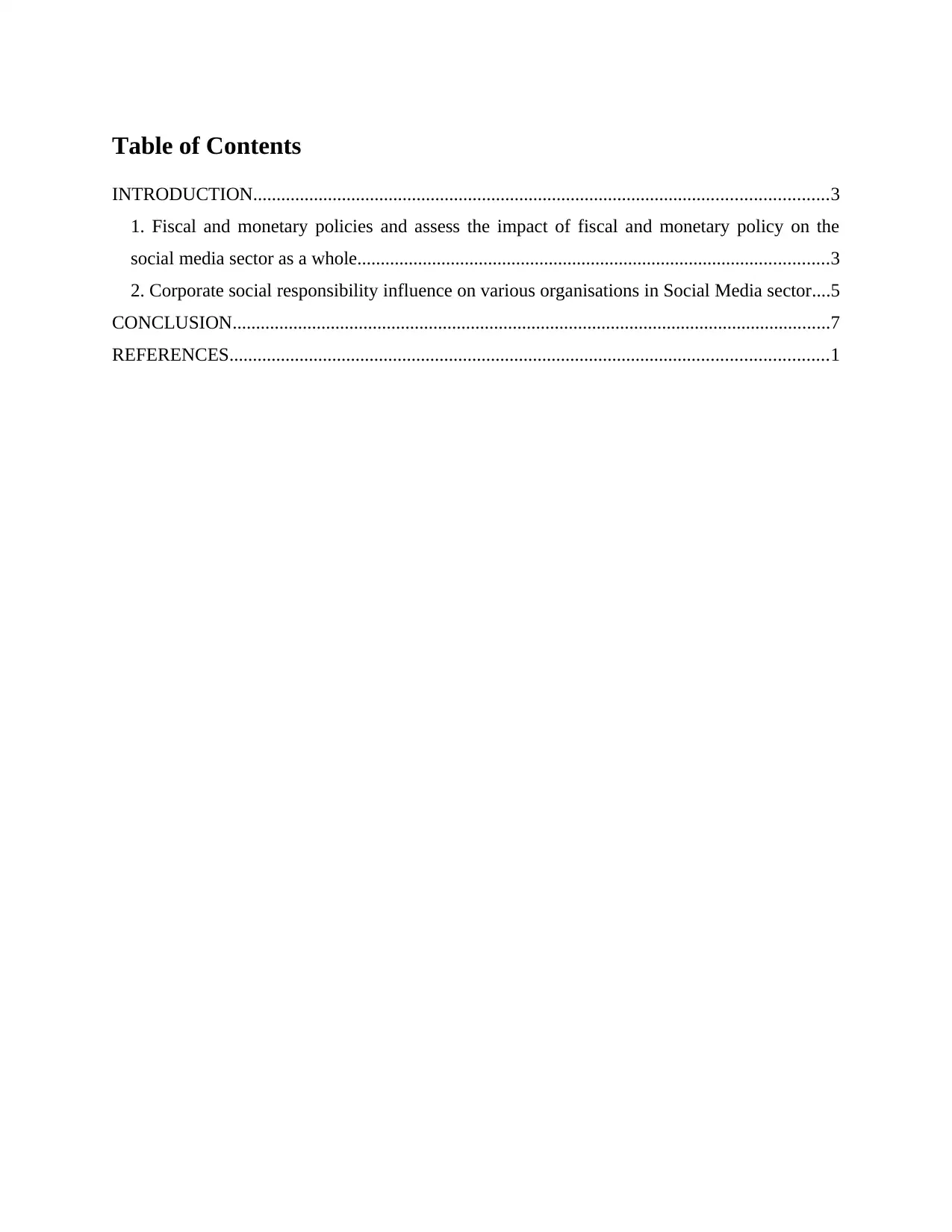
Table of Contents
INTRODUCTION...........................................................................................................................3
1. Fiscal and monetary policies and assess the impact of fiscal and monetary policy on the
social media sector as a whole.....................................................................................................3
2. Corporate social responsibility influence on various organisations in Social Media sector....5
CONCLUSION................................................................................................................................7
REFERENCES................................................................................................................................1
INTRODUCTION...........................................................................................................................3
1. Fiscal and monetary policies and assess the impact of fiscal and monetary policy on the
social media sector as a whole.....................................................................................................3
2. Corporate social responsibility influence on various organisations in Social Media sector....5
CONCLUSION................................................................................................................................7
REFERENCES................................................................................................................................1
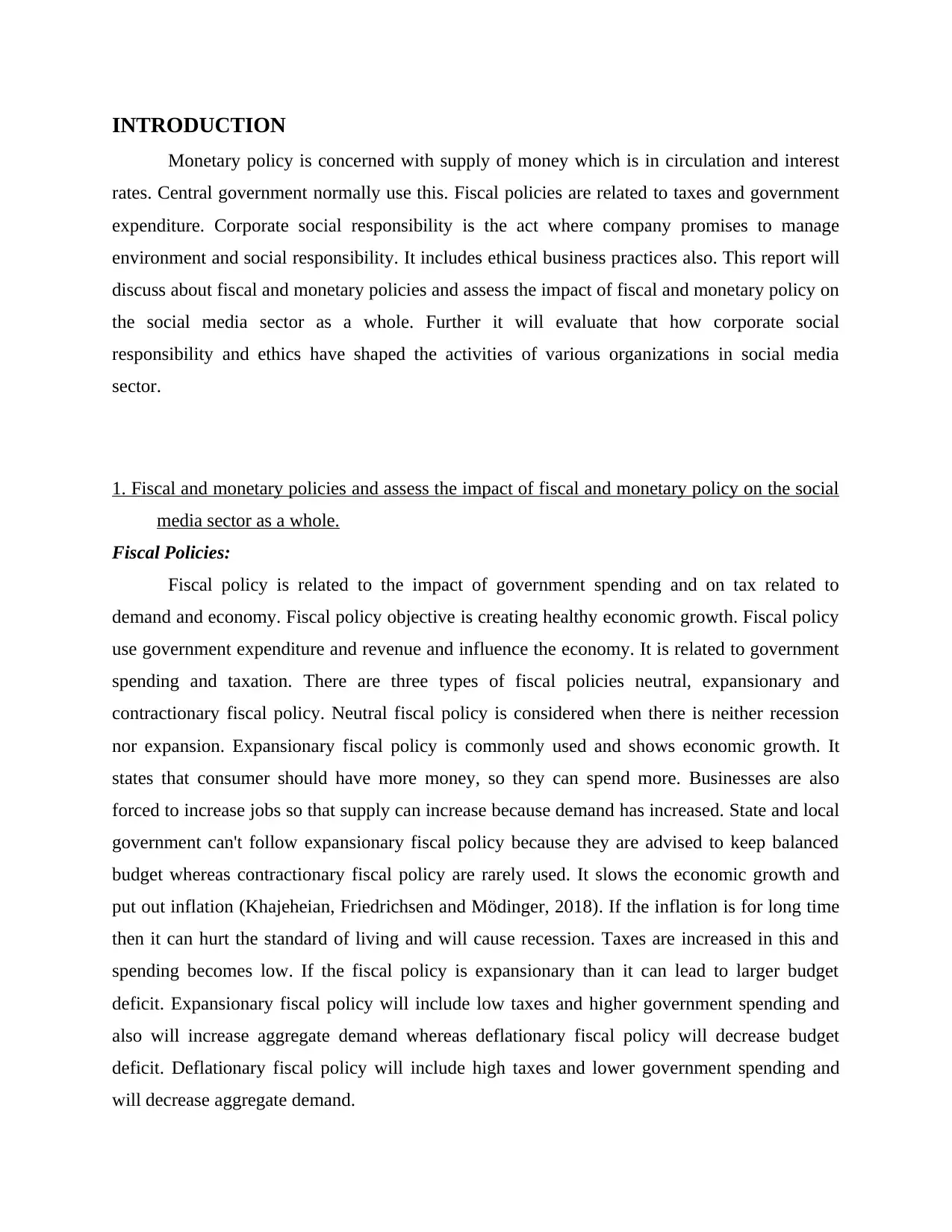
INTRODUCTION
Monetary policy is concerned with supply of money which is in circulation and interest
rates. Central government normally use this. Fiscal policies are related to taxes and government
expenditure. Corporate social responsibility is the act where company promises to manage
environment and social responsibility. It includes ethical business practices also. This report will
discuss about fiscal and monetary policies and assess the impact of fiscal and monetary policy on
the social media sector as a whole. Further it will evaluate that how corporate social
responsibility and ethics have shaped the activities of various organizations in social media
sector.
1. Fiscal and monetary policies and assess the impact of fiscal and monetary policy on the social
media sector as a whole.
Fiscal Policies:
Fiscal policy is related to the impact of government spending and on tax related to
demand and economy. Fiscal policy objective is creating healthy economic growth. Fiscal policy
use government expenditure and revenue and influence the economy. It is related to government
spending and taxation. There are three types of fiscal policies neutral, expansionary and
contractionary fiscal policy. Neutral fiscal policy is considered when there is neither recession
nor expansion. Expansionary fiscal policy is commonly used and shows economic growth. It
states that consumer should have more money, so they can spend more. Businesses are also
forced to increase jobs so that supply can increase because demand has increased. State and local
government can't follow expansionary fiscal policy because they are advised to keep balanced
budget whereas contractionary fiscal policy are rarely used. It slows the economic growth and
put out inflation (Khajeheian, Friedrichsen and Mödinger, 2018). If the inflation is for long time
then it can hurt the standard of living and will cause recession. Taxes are increased in this and
spending becomes low. If the fiscal policy is expansionary than it can lead to larger budget
deficit. Expansionary fiscal policy will include low taxes and higher government spending and
also will increase aggregate demand whereas deflationary fiscal policy will decrease budget
deficit. Deflationary fiscal policy will include high taxes and lower government spending and
will decrease aggregate demand.
Monetary policy is concerned with supply of money which is in circulation and interest
rates. Central government normally use this. Fiscal policies are related to taxes and government
expenditure. Corporate social responsibility is the act where company promises to manage
environment and social responsibility. It includes ethical business practices also. This report will
discuss about fiscal and monetary policies and assess the impact of fiscal and monetary policy on
the social media sector as a whole. Further it will evaluate that how corporate social
responsibility and ethics have shaped the activities of various organizations in social media
sector.
1. Fiscal and monetary policies and assess the impact of fiscal and monetary policy on the social
media sector as a whole.
Fiscal Policies:
Fiscal policy is related to the impact of government spending and on tax related to
demand and economy. Fiscal policy objective is creating healthy economic growth. Fiscal policy
use government expenditure and revenue and influence the economy. It is related to government
spending and taxation. There are three types of fiscal policies neutral, expansionary and
contractionary fiscal policy. Neutral fiscal policy is considered when there is neither recession
nor expansion. Expansionary fiscal policy is commonly used and shows economic growth. It
states that consumer should have more money, so they can spend more. Businesses are also
forced to increase jobs so that supply can increase because demand has increased. State and local
government can't follow expansionary fiscal policy because they are advised to keep balanced
budget whereas contractionary fiscal policy are rarely used. It slows the economic growth and
put out inflation (Khajeheian, Friedrichsen and Mödinger, 2018). If the inflation is for long time
then it can hurt the standard of living and will cause recession. Taxes are increased in this and
spending becomes low. If the fiscal policy is expansionary than it can lead to larger budget
deficit. Expansionary fiscal policy will include low taxes and higher government spending and
also will increase aggregate demand whereas deflationary fiscal policy will decrease budget
deficit. Deflationary fiscal policy will include high taxes and lower government spending and
will decrease aggregate demand.
⊘ This is a preview!⊘
Do you want full access?
Subscribe today to unlock all pages.

Trusted by 1+ million students worldwide
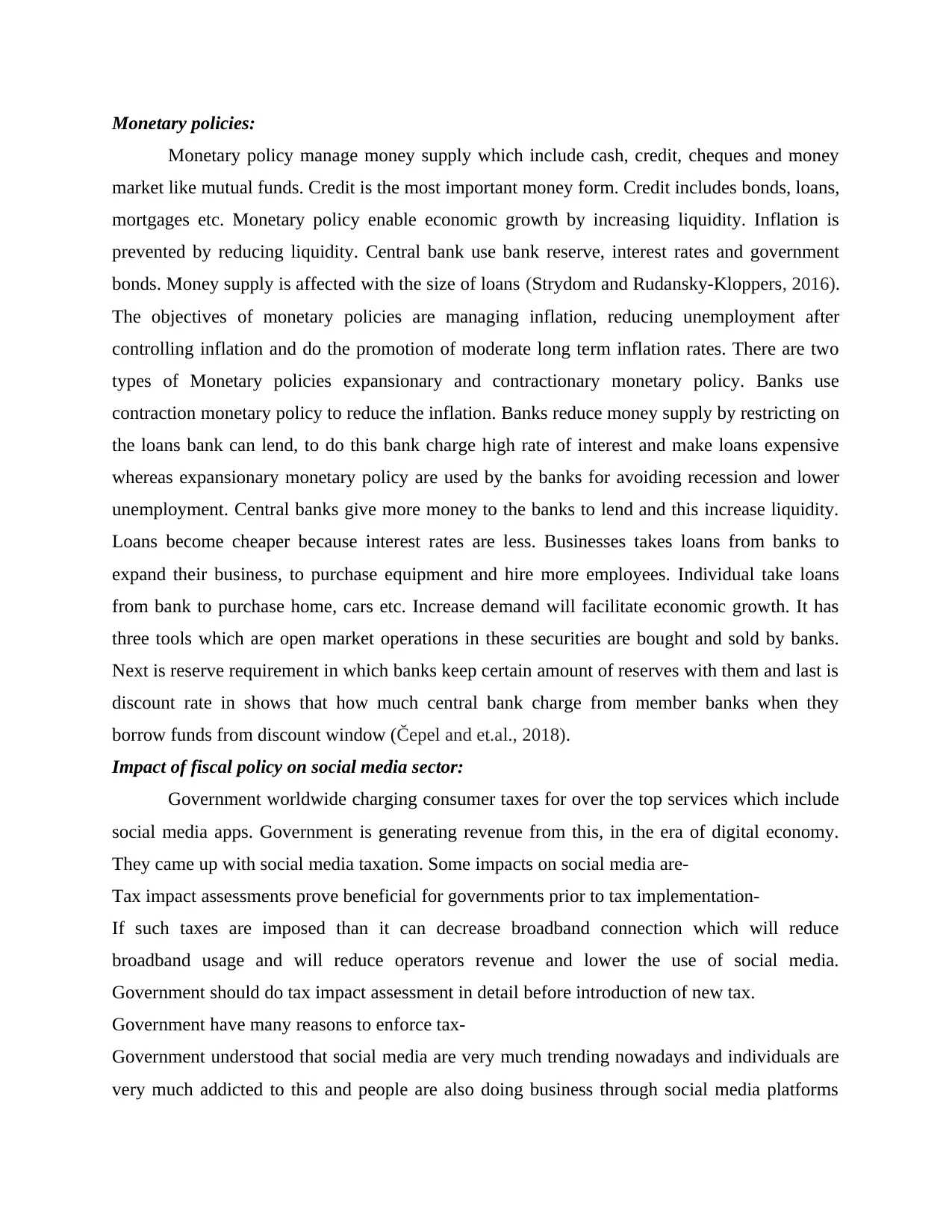
Monetary policies:
Monetary policy manage money supply which include cash, credit, cheques and money
market like mutual funds. Credit is the most important money form. Credit includes bonds, loans,
mortgages etc. Monetary policy enable economic growth by increasing liquidity. Inflation is
prevented by reducing liquidity. Central bank use bank reserve, interest rates and government
bonds. Money supply is affected with the size of loans (Strydom and Rudansky-Kloppers, 2016).
The objectives of monetary policies are managing inflation, reducing unemployment after
controlling inflation and do the promotion of moderate long term inflation rates. There are two
types of Monetary policies expansionary and contractionary monetary policy. Banks use
contraction monetary policy to reduce the inflation. Banks reduce money supply by restricting on
the loans bank can lend, to do this bank charge high rate of interest and make loans expensive
whereas expansionary monetary policy are used by the banks for avoiding recession and lower
unemployment. Central banks give more money to the banks to lend and this increase liquidity.
Loans become cheaper because interest rates are less. Businesses takes loans from banks to
expand their business, to purchase equipment and hire more employees. Individual take loans
from bank to purchase home, cars etc. Increase demand will facilitate economic growth. It has
three tools which are open market operations in these securities are bought and sold by banks.
Next is reserve requirement in which banks keep certain amount of reserves with them and last is
discount rate in shows that how much central bank charge from member banks when they
borrow funds from discount window (Čepel and et.al., 2018).
Impact of fiscal policy on social media sector:
Government worldwide charging consumer taxes for over the top services which include
social media apps. Government is generating revenue from this, in the era of digital economy.
They came up with social media taxation. Some impacts on social media are-
Tax impact assessments prove beneficial for governments prior to tax implementation-
If such taxes are imposed than it can decrease broadband connection which will reduce
broadband usage and will reduce operators revenue and lower the use of social media.
Government should do tax impact assessment in detail before introduction of new tax.
Government have many reasons to enforce tax-
Government understood that social media are very much trending nowadays and individuals are
very much addicted to this and people are also doing business through social media platforms
Monetary policy manage money supply which include cash, credit, cheques and money
market like mutual funds. Credit is the most important money form. Credit includes bonds, loans,
mortgages etc. Monetary policy enable economic growth by increasing liquidity. Inflation is
prevented by reducing liquidity. Central bank use bank reserve, interest rates and government
bonds. Money supply is affected with the size of loans (Strydom and Rudansky-Kloppers, 2016).
The objectives of monetary policies are managing inflation, reducing unemployment after
controlling inflation and do the promotion of moderate long term inflation rates. There are two
types of Monetary policies expansionary and contractionary monetary policy. Banks use
contraction monetary policy to reduce the inflation. Banks reduce money supply by restricting on
the loans bank can lend, to do this bank charge high rate of interest and make loans expensive
whereas expansionary monetary policy are used by the banks for avoiding recession and lower
unemployment. Central banks give more money to the banks to lend and this increase liquidity.
Loans become cheaper because interest rates are less. Businesses takes loans from banks to
expand their business, to purchase equipment and hire more employees. Individual take loans
from bank to purchase home, cars etc. Increase demand will facilitate economic growth. It has
three tools which are open market operations in these securities are bought and sold by banks.
Next is reserve requirement in which banks keep certain amount of reserves with them and last is
discount rate in shows that how much central bank charge from member banks when they
borrow funds from discount window (Čepel and et.al., 2018).
Impact of fiscal policy on social media sector:
Government worldwide charging consumer taxes for over the top services which include
social media apps. Government is generating revenue from this, in the era of digital economy.
They came up with social media taxation. Some impacts on social media are-
Tax impact assessments prove beneficial for governments prior to tax implementation-
If such taxes are imposed than it can decrease broadband connection which will reduce
broadband usage and will reduce operators revenue and lower the use of social media.
Government should do tax impact assessment in detail before introduction of new tax.
Government have many reasons to enforce tax-
Government understood that social media are very much trending nowadays and individuals are
very much addicted to this and people are also doing business through social media platforms
Paraphrase This Document
Need a fresh take? Get an instant paraphrase of this document with our AI Paraphraser
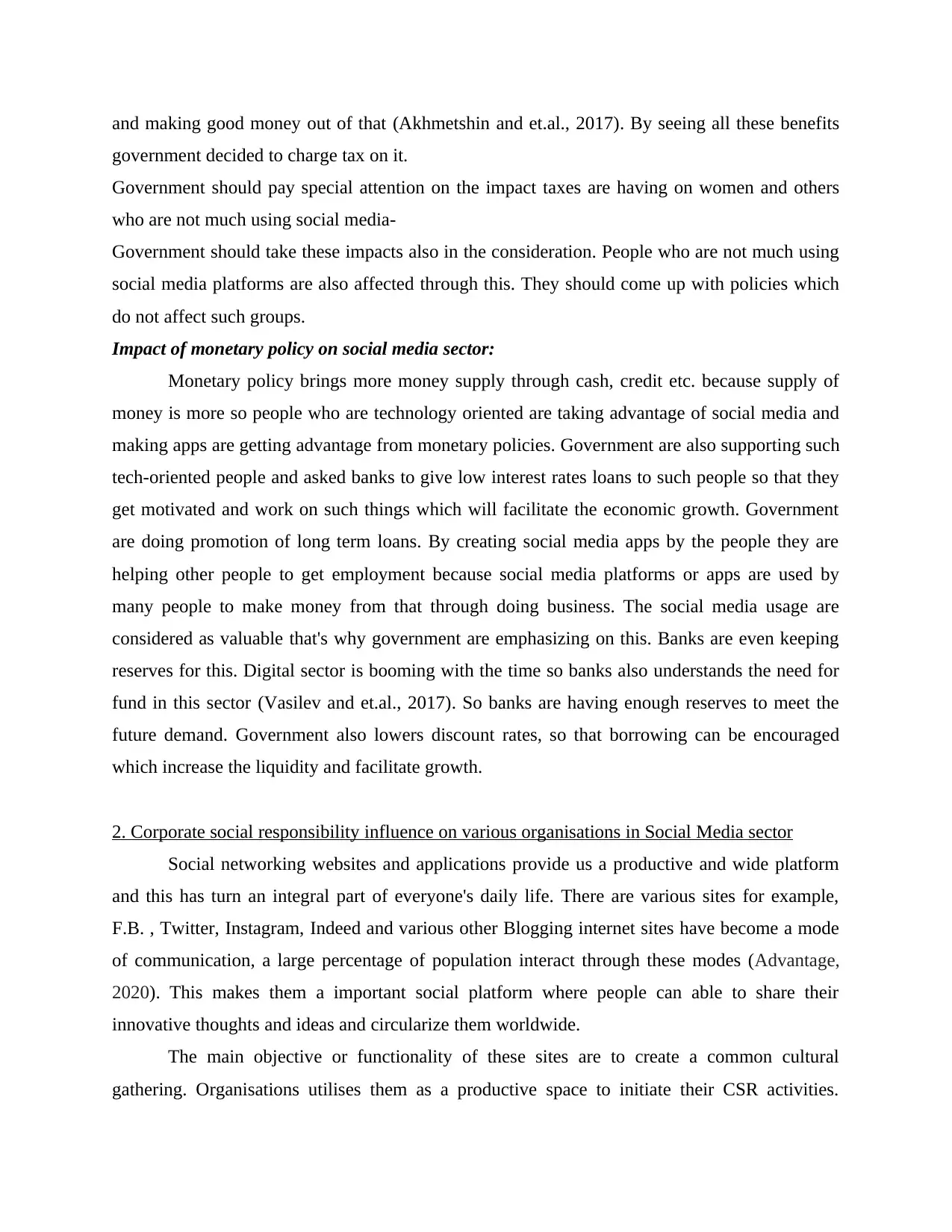
and making good money out of that (Akhmetshin and et.al., 2017). By seeing all these benefits
government decided to charge tax on it.
Government should pay special attention on the impact taxes are having on women and others
who are not much using social media-
Government should take these impacts also in the consideration. People who are not much using
social media platforms are also affected through this. They should come up with policies which
do not affect such groups.
Impact of monetary policy on social media sector:
Monetary policy brings more money supply through cash, credit etc. because supply of
money is more so people who are technology oriented are taking advantage of social media and
making apps are getting advantage from monetary policies. Government are also supporting such
tech-oriented people and asked banks to give low interest rates loans to such people so that they
get motivated and work on such things which will facilitate the economic growth. Government
are doing promotion of long term loans. By creating social media apps by the people they are
helping other people to get employment because social media platforms or apps are used by
many people to make money from that through doing business. The social media usage are
considered as valuable that's why government are emphasizing on this. Banks are even keeping
reserves for this. Digital sector is booming with the time so banks also understands the need for
fund in this sector (Vasilev and et.al., 2017). So banks are having enough reserves to meet the
future demand. Government also lowers discount rates, so that borrowing can be encouraged
which increase the liquidity and facilitate growth.
2. Corporate social responsibility influence on various organisations in Social Media sector
Social networking websites and applications provide us a productive and wide platform
and this has turn an integral part of everyone's daily life. There are various sites for example,
F.B. , Twitter, Instagram, Indeed and various other Blogging internet sites have become a mode
of communication, a large percentage of population interact through these modes (Advantage,
2020). This makes them a important social platform where people can able to share their
innovative thoughts and ideas and circularize them worldwide.
The main objective or functionality of these sites are to create a common cultural
gathering. Organisations utilises them as a productive space to initiate their CSR activities.
government decided to charge tax on it.
Government should pay special attention on the impact taxes are having on women and others
who are not much using social media-
Government should take these impacts also in the consideration. People who are not much using
social media platforms are also affected through this. They should come up with policies which
do not affect such groups.
Impact of monetary policy on social media sector:
Monetary policy brings more money supply through cash, credit etc. because supply of
money is more so people who are technology oriented are taking advantage of social media and
making apps are getting advantage from monetary policies. Government are also supporting such
tech-oriented people and asked banks to give low interest rates loans to such people so that they
get motivated and work on such things which will facilitate the economic growth. Government
are doing promotion of long term loans. By creating social media apps by the people they are
helping other people to get employment because social media platforms or apps are used by
many people to make money from that through doing business. The social media usage are
considered as valuable that's why government are emphasizing on this. Banks are even keeping
reserves for this. Digital sector is booming with the time so banks also understands the need for
fund in this sector (Vasilev and et.al., 2017). So banks are having enough reserves to meet the
future demand. Government also lowers discount rates, so that borrowing can be encouraged
which increase the liquidity and facilitate growth.
2. Corporate social responsibility influence on various organisations in Social Media sector
Social networking websites and applications provide us a productive and wide platform
and this has turn an integral part of everyone's daily life. There are various sites for example,
F.B. , Twitter, Instagram, Indeed and various other Blogging internet sites have become a mode
of communication, a large percentage of population interact through these modes (Advantage,
2020). This makes them a important social platform where people can able to share their
innovative thoughts and ideas and circularize them worldwide.
The main objective or functionality of these sites are to create a common cultural
gathering. Organisations utilises them as a productive space to initiate their CSR activities.
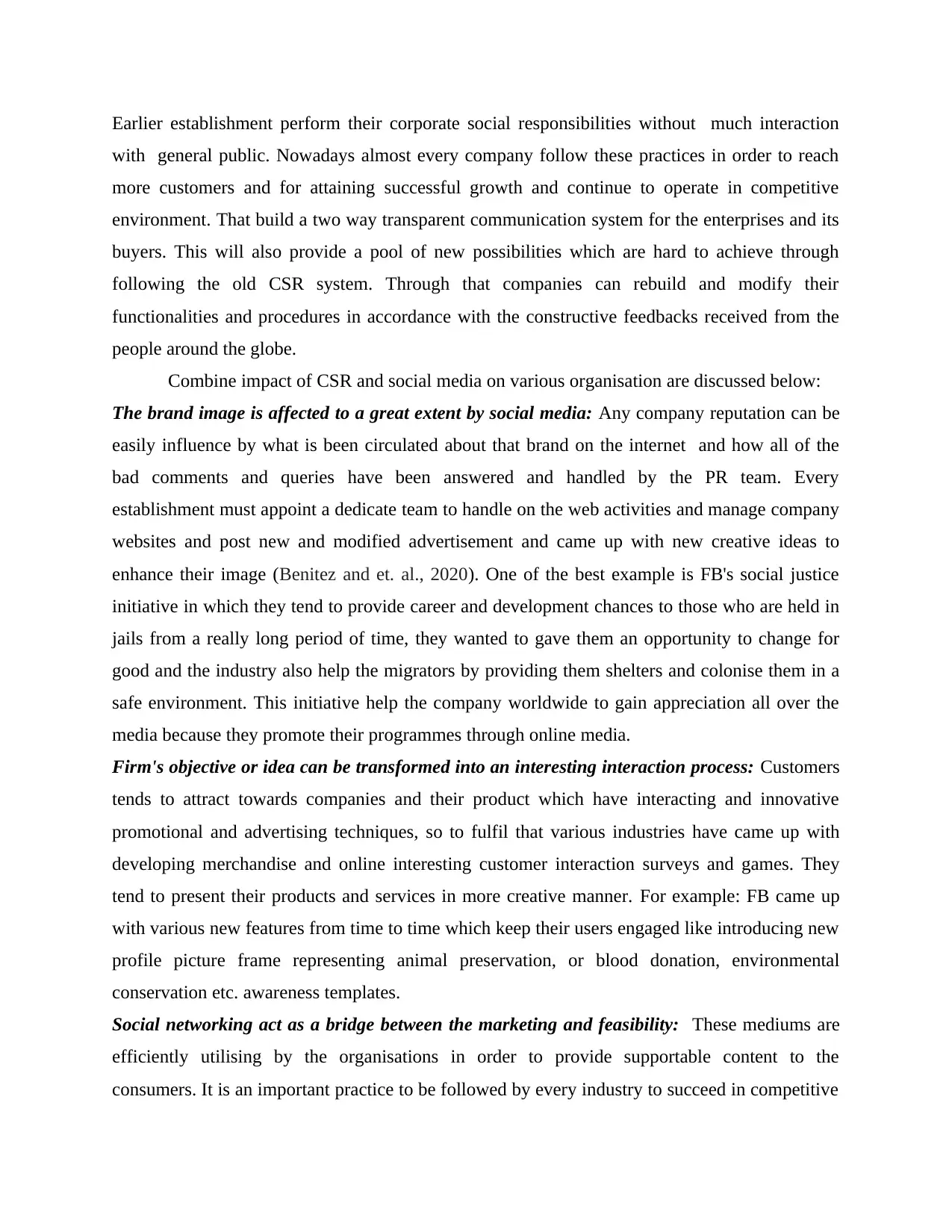
Earlier establishment perform their corporate social responsibilities without much interaction
with general public. Nowadays almost every company follow these practices in order to reach
more customers and for attaining successful growth and continue to operate in competitive
environment. That build a two way transparent communication system for the enterprises and its
buyers. This will also provide a pool of new possibilities which are hard to achieve through
following the old CSR system. Through that companies can rebuild and modify their
functionalities and procedures in accordance with the constructive feedbacks received from the
people around the globe.
Combine impact of CSR and social media on various organisation are discussed below:
The brand image is affected to a great extent by social media: Any company reputation can be
easily influence by what is been circulated about that brand on the internet and how all of the
bad comments and queries have been answered and handled by the PR team. Every
establishment must appoint a dedicate team to handle on the web activities and manage company
websites and post new and modified advertisement and came up with new creative ideas to
enhance their image (Benitez and et. al., 2020). One of the best example is FB's social justice
initiative in which they tend to provide career and development chances to those who are held in
jails from a really long period of time, they wanted to gave them an opportunity to change for
good and the industry also help the migrators by providing them shelters and colonise them in a
safe environment. This initiative help the company worldwide to gain appreciation all over the
media because they promote their programmes through online media.
Firm's objective or idea can be transformed into an interesting interaction process: Customers
tends to attract towards companies and their product which have interacting and innovative
promotional and advertising techniques, so to fulfil that various industries have came up with
developing merchandise and online interesting customer interaction surveys and games. They
tend to present their products and services in more creative manner. For example: FB came up
with various new features from time to time which keep their users engaged like introducing new
profile picture frame representing animal preservation, or blood donation, environmental
conservation etc. awareness templates.
Social networking act as a bridge between the marketing and feasibility: These mediums are
efficiently utilising by the organisations in order to provide supportable content to the
consumers. It is an important practice to be followed by every industry to succeed in competitive
with general public. Nowadays almost every company follow these practices in order to reach
more customers and for attaining successful growth and continue to operate in competitive
environment. That build a two way transparent communication system for the enterprises and its
buyers. This will also provide a pool of new possibilities which are hard to achieve through
following the old CSR system. Through that companies can rebuild and modify their
functionalities and procedures in accordance with the constructive feedbacks received from the
people around the globe.
Combine impact of CSR and social media on various organisation are discussed below:
The brand image is affected to a great extent by social media: Any company reputation can be
easily influence by what is been circulated about that brand on the internet and how all of the
bad comments and queries have been answered and handled by the PR team. Every
establishment must appoint a dedicate team to handle on the web activities and manage company
websites and post new and modified advertisement and came up with new creative ideas to
enhance their image (Benitez and et. al., 2020). One of the best example is FB's social justice
initiative in which they tend to provide career and development chances to those who are held in
jails from a really long period of time, they wanted to gave them an opportunity to change for
good and the industry also help the migrators by providing them shelters and colonise them in a
safe environment. This initiative help the company worldwide to gain appreciation all over the
media because they promote their programmes through online media.
Firm's objective or idea can be transformed into an interesting interaction process: Customers
tends to attract towards companies and their product which have interacting and innovative
promotional and advertising techniques, so to fulfil that various industries have came up with
developing merchandise and online interesting customer interaction surveys and games. They
tend to present their products and services in more creative manner. For example: FB came up
with various new features from time to time which keep their users engaged like introducing new
profile picture frame representing animal preservation, or blood donation, environmental
conservation etc. awareness templates.
Social networking act as a bridge between the marketing and feasibility: These mediums are
efficiently utilising by the organisations in order to provide supportable content to the
consumers. It is an important practice to be followed by every industry to succeed in competitive
⊘ This is a preview!⊘
Do you want full access?
Subscribe today to unlock all pages.

Trusted by 1+ million students worldwide

market. This can only be achieved if their objectives and information is effectively transmitted t
the audience by using efficient online promotional and marketing.
Firms have to face both positive as well as negative feedbacks: These platforms also facilitate
the audience to share their feedbacks and comments if they are not satisfied and disagreed with
any companies functionality and operating activities. People are more aware and knowledgeable
in the present era, they like to keep track of not only on the product of any brand but also on their
every move and activities going on in the environment. Customers may be satisfied or happy
with the product but that doesn't really means that they are happy with the overall establishment.
For example: People have started a movement on social networking applications and sites to
oppose companies who are doing destruction to the forests and vegetation but Facebook works
towards decreasing their carbon footprints and discharge or gaseous and chemical wastages.
They have committed in the past and live up to their commitments as they establish their offices
with minimal water wastage plants and give emphasise on planting more tress and provide a
sustainable atmosphere.
It develop a global interaction space: Online networking and media sites have become more
popular among the generation and businesses as they are facilitated with a open space to interact
directly with their buyers and can listen and resolve their queries, consumers can also
communicate with the company and their associates regarding any issue for the product and their
services or can also provide satisfactory and happy comments to their supplier etc. Through this
businesses can know what their customers really want from them an where are they lacking
(George, 2017). Many companies do their discussion and public debate on live streams, of which
people can be a part of. For example: Facebook has started a online debate which is a improved
approaching meeting, which involves several intellectual persons, answering questions and
inquiry asked by various small and large business personal, entrepreneur and general public. This
global initiative reach at its maximum in one day and made this programme a great success.
CONCLUSION
The above report has evaluated the fiscal and monetary policies and analysed their direct
and indirect inter-relatedness with the social media aspects. Fiscal policy has influence on
government expenditures and taxes. Monetary policy pull off credits, bill of exchange and supply
of monetary funds for wealth market. Further the report examines that how various organisation
the audience by using efficient online promotional and marketing.
Firms have to face both positive as well as negative feedbacks: These platforms also facilitate
the audience to share their feedbacks and comments if they are not satisfied and disagreed with
any companies functionality and operating activities. People are more aware and knowledgeable
in the present era, they like to keep track of not only on the product of any brand but also on their
every move and activities going on in the environment. Customers may be satisfied or happy
with the product but that doesn't really means that they are happy with the overall establishment.
For example: People have started a movement on social networking applications and sites to
oppose companies who are doing destruction to the forests and vegetation but Facebook works
towards decreasing their carbon footprints and discharge or gaseous and chemical wastages.
They have committed in the past and live up to their commitments as they establish their offices
with minimal water wastage plants and give emphasise on planting more tress and provide a
sustainable atmosphere.
It develop a global interaction space: Online networking and media sites have become more
popular among the generation and businesses as they are facilitated with a open space to interact
directly with their buyers and can listen and resolve their queries, consumers can also
communicate with the company and their associates regarding any issue for the product and their
services or can also provide satisfactory and happy comments to their supplier etc. Through this
businesses can know what their customers really want from them an where are they lacking
(George, 2017). Many companies do their discussion and public debate on live streams, of which
people can be a part of. For example: Facebook has started a online debate which is a improved
approaching meeting, which involves several intellectual persons, answering questions and
inquiry asked by various small and large business personal, entrepreneur and general public. This
global initiative reach at its maximum in one day and made this programme a great success.
CONCLUSION
The above report has evaluated the fiscal and monetary policies and analysed their direct
and indirect inter-relatedness with the social media aspects. Fiscal policy has influence on
government expenditures and taxes. Monetary policy pull off credits, bill of exchange and supply
of monetary funds for wealth market. Further the report examines that how various organisation
Paraphrase This Document
Need a fresh take? Get an instant paraphrase of this document with our AI Paraphraser

chooses online networking tools to enhance and promote their corporate social responsibilities
activity. That gave a brief understanding that efficient utilisation of online media can leads to
enhance establishments overall potential and growth and act as a key factor to modify future
longevity.
activity. That gave a brief understanding that efficient utilisation of online media can leads to
enhance establishments overall potential and growth and act as a key factor to modify future
longevity.
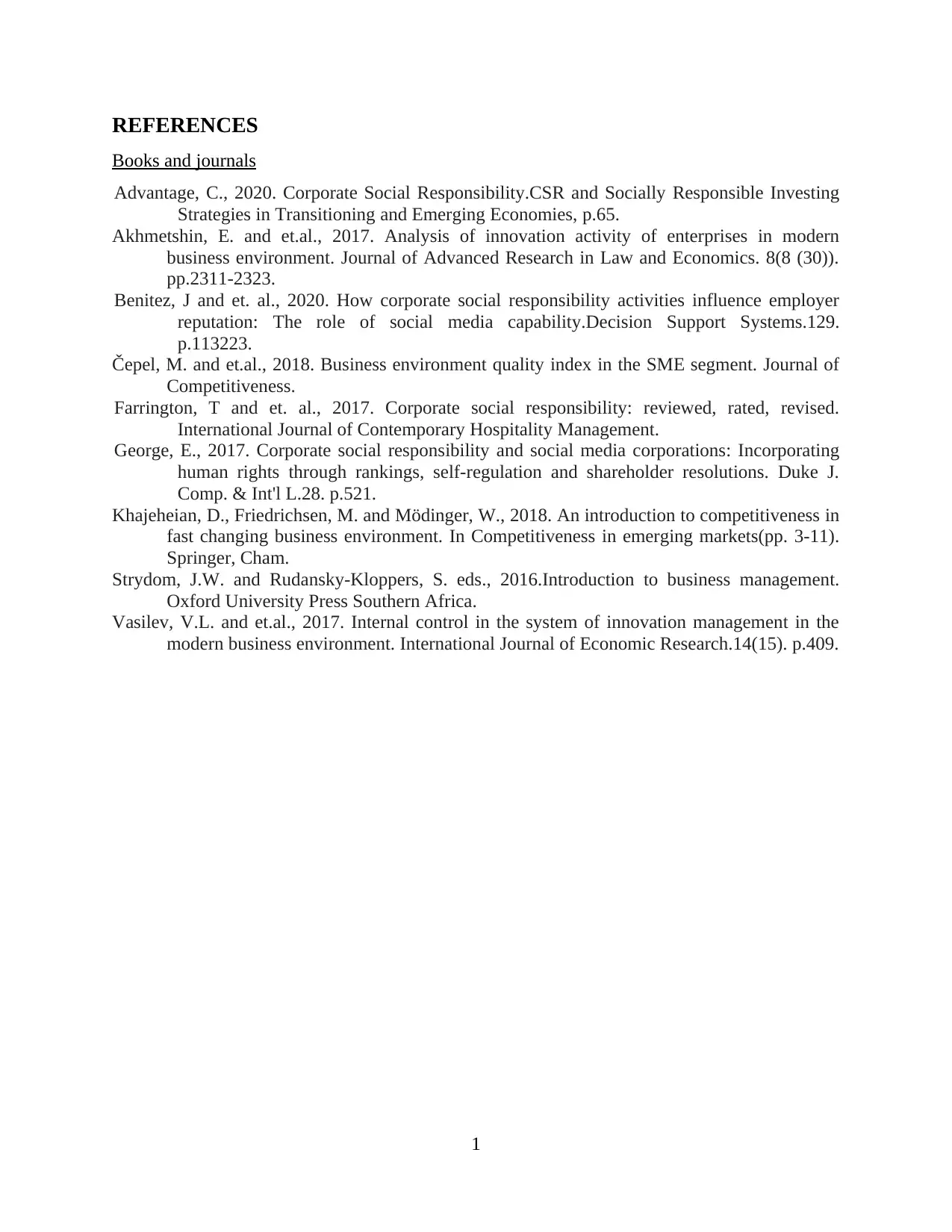
REFERENCES
Books and journals
Advantage, C., 2020. Corporate Social Responsibility.CSR and Socially Responsible Investing
Strategies in Transitioning and Emerging Economies, p.65.
Akhmetshin, E. and et.al., 2017. Analysis of innovation activity of enterprises in modern
business environment. Journal of Advanced Research in Law and Economics. 8(8 (30)).
pp.2311-2323.
Benitez, J and et. al., 2020. How corporate social responsibility activities influence employer
reputation: The role of social media capability.Decision Support Systems.129.
p.113223.
Čepel, M. and et.al., 2018. Business environment quality index in the SME segment. Journal of
Competitiveness.
Farrington, T and et. al., 2017. Corporate social responsibility: reviewed, rated, revised.
International Journal of Contemporary Hospitality Management.
George, E., 2017. Corporate social responsibility and social media corporations: Incorporating
human rights through rankings, self-regulation and shareholder resolutions. Duke J.
Comp. & Int'l L.28. p.521.
Khajeheian, D., Friedrichsen, M. and Mödinger, W., 2018. An introduction to competitiveness in
fast changing business environment. In Competitiveness in emerging markets(pp. 3-11).
Springer, Cham.
Strydom, J.W. and Rudansky-Kloppers, S. eds., 2016.Introduction to business management.
Oxford University Press Southern Africa.
Vasilev, V.L. and et.al., 2017. Internal control in the system of innovation management in the
modern business environment. International Journal of Economic Research.14(15). p.409.
1
Books and journals
Advantage, C., 2020. Corporate Social Responsibility.CSR and Socially Responsible Investing
Strategies in Transitioning and Emerging Economies, p.65.
Akhmetshin, E. and et.al., 2017. Analysis of innovation activity of enterprises in modern
business environment. Journal of Advanced Research in Law and Economics. 8(8 (30)).
pp.2311-2323.
Benitez, J and et. al., 2020. How corporate social responsibility activities influence employer
reputation: The role of social media capability.Decision Support Systems.129.
p.113223.
Čepel, M. and et.al., 2018. Business environment quality index in the SME segment. Journal of
Competitiveness.
Farrington, T and et. al., 2017. Corporate social responsibility: reviewed, rated, revised.
International Journal of Contemporary Hospitality Management.
George, E., 2017. Corporate social responsibility and social media corporations: Incorporating
human rights through rankings, self-regulation and shareholder resolutions. Duke J.
Comp. & Int'l L.28. p.521.
Khajeheian, D., Friedrichsen, M. and Mödinger, W., 2018. An introduction to competitiveness in
fast changing business environment. In Competitiveness in emerging markets(pp. 3-11).
Springer, Cham.
Strydom, J.W. and Rudansky-Kloppers, S. eds., 2016.Introduction to business management.
Oxford University Press Southern Africa.
Vasilev, V.L. and et.al., 2017. Internal control in the system of innovation management in the
modern business environment. International Journal of Economic Research.14(15). p.409.
1
⊘ This is a preview!⊘
Do you want full access?
Subscribe today to unlock all pages.

Trusted by 1+ million students worldwide

2
1 out of 10
Related Documents
Your All-in-One AI-Powered Toolkit for Academic Success.
+13062052269
info@desklib.com
Available 24*7 on WhatsApp / Email
![[object Object]](/_next/static/media/star-bottom.7253800d.svg)
Unlock your academic potential
Copyright © 2020–2025 A2Z Services. All Rights Reserved. Developed and managed by ZUCOL.





